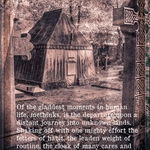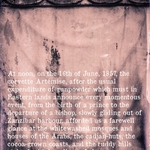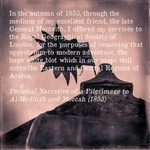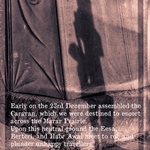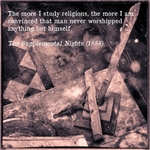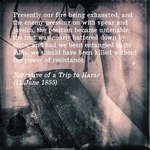Sir Richard Francis Burton
KCMG FRGS (19 March 1821- 20 October 1890)
Burton was an English explorer, geographer, translator, writer, soldier, orientalist, cartographer,
ethnologist, spy, linguist, poet, fencer, and diplomat. He was famed for his travels and explorations in Asia, Africa and the Americas, as well as his extraordinary knowledge of languages and cultures.
According to one count, he spoke 29 European, Asian and African languages.
Burton's best-known achievements include a well documented journey to Mecca, in disguise at a time when Europeans were forbidden access on pain of death; an unexpurgated translation of One Thousand and One Nights (commonly called The Arabian Nights); the publication of the Kama Sutra in English; and a journey with John Hanning Speke as the first Europeans to visit the Great Lakes of Africa in search of the source of the Nile.
Burton defied many aspects of the pervasive British ethnocentrism of his day, relishing personal contact with human cultures in all their variety. His works and letters extensively criticised colonial policies of the British Empire, even to the detriment of his career. He was a prolific and erudite author who wrote numerous books and scholarly articles about subjects including human behaviour, travel, falconry, fencing, sexual practices and ethnography.
Burton was a captain in the army of the East India Company, serving in India and in the Crimean War. Following this, he was engaged by the Royal Geographical Society to explore the east coast of Africa and led an expedition guided by the locals and was the first European to see Lake Tanganyika.
In later life, he served as British consul in Fernando Po, Santos, Damascus and, finally, Trieste.
He was a Fellow of the Royal Geographical Society and was awarded a knighthood (KCMG) in 1886.
The mausoleum of Sir Richard and Lady Isabel Burton is in the cemetery of St. Mary Magdalen Roman Catholic Church, Mortlake, West London.
The mausoleum is in the shape of an Arab tent and the coffins can be seen through a window at the rear.
When Burton died in 1890, Isabel had the mausoleum built, and paid for the stained glass memorial window in the church.
The quotations overlying the photographs are taken from a few of Burton’s numerous books.
Burton was an English explorer, geographer, translator, writer, soldier, orientalist, cartographer,
ethnologist, spy, linguist, poet, fencer, and diplomat. He was famed for his travels and explorations in Asia, Africa and the Americas, as well as his extraordinary knowledge of languages and cultures.
According to one count, he spoke 29 European, Asian and African languages.
Burton's best-known achievements include a well documented journey to Mecca, in disguise at a time when Europeans were forbidden access on pain of death; an unexpurgated translation of One Thousand and One Nights (commonly called The Arabian Nights); the publication of the Kama Sutra in English; and a journey with John Hanning Speke as the first Europeans to visit the Great Lakes of Africa in search of the source of the Nile.
Burton defied many aspects of the pervasive British ethnocentrism of his day, relishing personal contact with human cultures in all their variety. His works and letters extensively criticised colonial policies of the British Empire, even to the detriment of his career. He was a prolific and erudite author who wrote numerous books and scholarly articles about subjects including human behaviour, travel, falconry, fencing, sexual practices and ethnography.
Burton was a captain in the army of the East India Company, serving in India and in the Crimean War. Following this, he was engaged by the Royal Geographical Society to explore the east coast of Africa and led an expedition guided by the locals and was the first European to see Lake Tanganyika.
In later life, he served as British consul in Fernando Po, Santos, Damascus and, finally, Trieste.
He was a Fellow of the Royal Geographical Society and was awarded a knighthood (KCMG) in 1886.
The mausoleum of Sir Richard and Lady Isabel Burton is in the cemetery of St. Mary Magdalen Roman Catholic Church, Mortlake, West London.
The mausoleum is in the shape of an Arab tent and the coffins can be seen through a window at the rear.
When Burton died in 1890, Isabel had the mausoleum built, and paid for the stained glass memorial window in the church.
The quotations overlying the photographs are taken from a few of Burton’s numerous books.
Return to: Gallery
Return to: Gallery
